The Flaming Star Nebula (IC 405) is an emission and reflection nebula located approximately 1,500 light-years away in the northern constellation Auriga. The nebula surrounds the hot blue variable star AE Aurigae. With an apparent magnitude of 6.0 and an apparent size of 37 by 10 arcminutes, it is one of the true gems of the winter night sky and a popular target for amateur astronomers.
IC 405 is illuminated by the young O-type main sequence dwarf AE Aurigae. It was named the Flaming Star Nebula because it contains extensive smoke-like filaments that make AE Aurigae look like it is on fire in long-exposure photographs. The nebular material that looks like smoke is mostly composed of hydrogen, but the dark filaments are made up of carbon-rich dust.
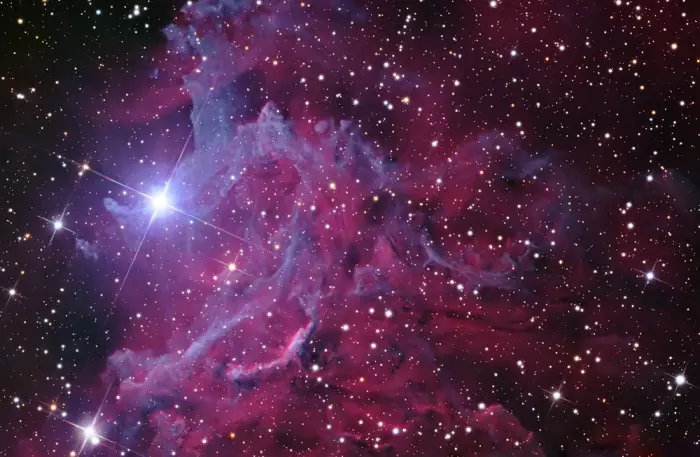
The Flaming Star Nebula (IC 405), image: Adam Block/Mount Lemmon SkyCenter/University of Arizona (CC BY-SA 4.0)
The name Flaming Star comes from the German astronomer and astrophotographer Max Wolf (1863-1932). Wolf found the nebula while photographing Nova Aurigae 1891. He described the star AE Aurigae as a “burning body from which several enormous curved flames seem to break out like gigantic prominences,” noting that the “flaming star” seemed to be physically associated with the nebulosity.
The Flaming Star Nebula is about five light-years across. It is composed of different regions that glow in red, purple, and blue tones in images.
The hot blue star AE Aurigae emits so much light that it knocks away electrons from the gas that surrounds it, ionizing the nebula. When a high-energy proton emitted from the hot star recaptures an electron, red light is often emitted and the nebula glows red. The red regions comprise the emission nebula. Other parts of the nebula glow in bluish tones because the blue light of the hot star is reflected by the surrounding dust. The blue parts make up the reflection nebula. The purple parts of the nebula are a mix of emission and reflection regions.
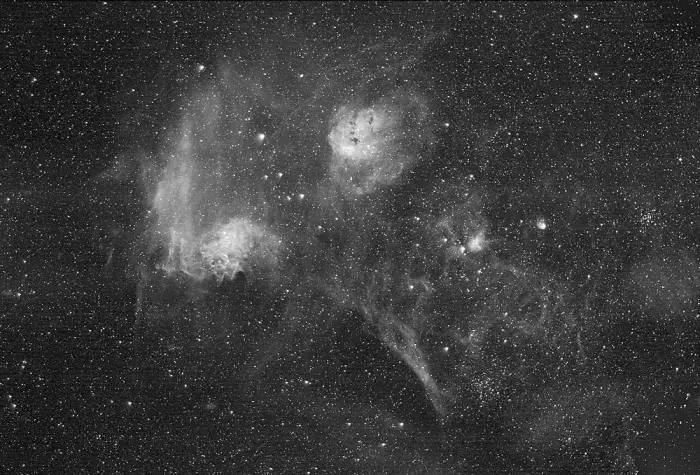
The Flaming Star Nebula and the Tadpole Nebula (IC 405 and IC 410) in H-alpha. Processing: Raw conversion and calibration with ImagesPlus; Aligning and combing with Registar; Gray conversion, levels adjustment, cropping/resizing, JPEG conversion with Photoshop CS. No sharpening or noise reduction. Image credit: Wikimedia Commons/s58y (CC BY 2.0)
The Flaming Star Nebula was discovered by the German-born American astronomer John Martin Schaeberle in 1892. It was independently found by astrophotographers Max Wolf and Eugen von Gothard.
The nebula is catalogued as Caldwell 31 in the Caldwell catalogue of deep sky objects visible in amateur telescopes. It has the designation Sharpless 229 (Sh2-229) in the Sharpless catalogue of H II regions.
AE Aurigae
AE Aurigae is a young main sequence star of the spectral type O9.5V. It is an exceptionally hot, massive, and luminous star. It has a mass 23 times that of the Sun and a radius 7.47 times solar. With an effective temperature of 33,000 K, it is 59,000 times more luminous than the Sun.
Even though it is only a few million years old, AE Aurigae will not live very long. O-type stars burn through their supply of hydrogen fuel fast due to their high mass and go out as supernovae in less than 10 million years.
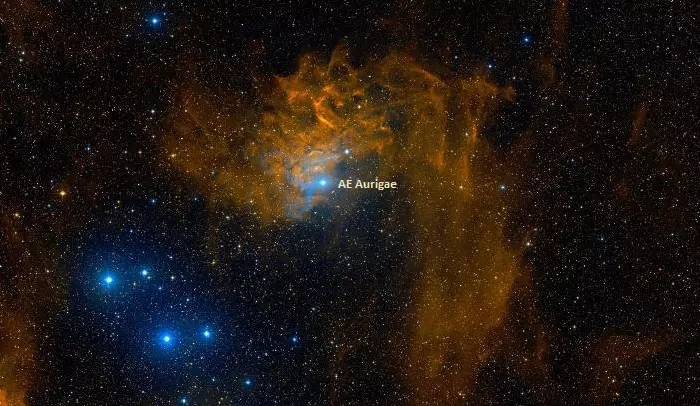
AE Aurigae in the Flaming Star Nebula, image: Wikisky
AE Aurigae is classified as an Orion variable star. It exhibits irregular variations in luminosity and its brightness varies from magnitude 5.78 to 6.08.
The star lights up the Flaming Star Nebula, but the nebula is not its birthplace. The two have different radial velocities. AE Aurigae is a runaway star believed to have originated in the Trapezium Cluster in the Orion Nebula (Messier 42).
Runaway stars pass through the interstellar medium at supersonic velocities. Based on measurements of the radial velocity and proper motion of AE Aurigae, astronomers believe that the star’s point of origin intersects with the multiple-star system Iota Orionis (Hatysa). AE Aurigae may have been expelled during a collision of two massive binary systems about 2-3 million years ago. Iota Orionis in Orion’s Sword may have taken part in the collision. The hot blue stars Mu Columbae and 53 Arietis might have also been ejected in the same collision.
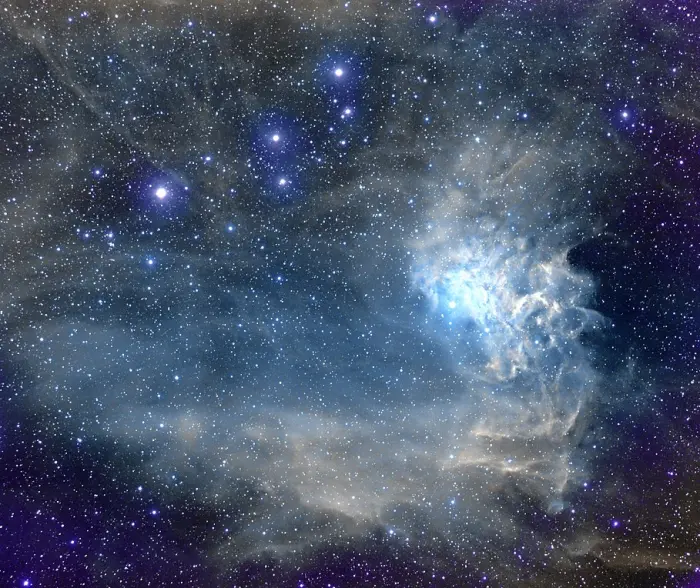
The Flaming Star Nebula (Caldwell 31), image credit: Ram Samudrala (CC0 1.0)
AE Aurigae has only recently run into IC 405 and is now interacting with the dense molecular nebula. Once it leaves the nebula, IC 405 will fade. As the star passes through IC 405 at high speed, it creates a powerful bow shock, producing a large number of high-energy protons that can be detected in X-rays. In 2012, a team of astronomers detected X-ray emissions from the bow shock. This was the first instance of the detection of X-ray emission from a bow shock created by a runaway star.
The first evidence for interaction between AE Aurigae and the nebular material of IC 405 was detected by the Infrared Astronomical Satellite (IRAS), the first infrared space telescope, in the mid-1990s. The bow shock was directly imaged by the Spitzer Space Telescope in 2006.
Location
The Flaming Star Nebula is easy to find because it lies within a conspicuous winter asterism, Auriga’s hexagon. It can be observed in a small telescope. In exceptionally good conditions, it can be spotted in a 2.4-inch telescope, but if there is any light pollution, it may not be visible even in larger instruments.
The dominant pattern of the celestial Charioteer – a large hexagon – is formed by Capella, the sixth brightest star in the sky, with Menkalinan, Almaaz, Mahasim, Hassaleh, and Elnath. The last of these stars, Elnath, is not part of the constellation Auriga. It marks the northern horn of the Bull and is the second brightest star in Taurus (after Aldebaran).
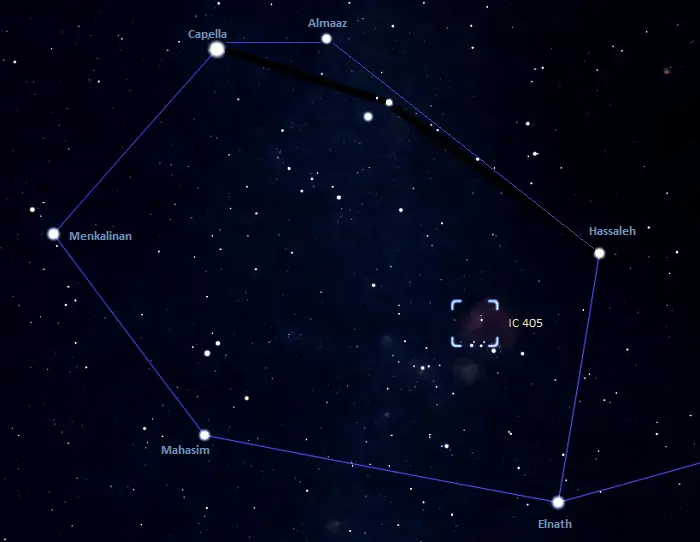
The location of the Flaming Star Nebula (IC 405), image: Stellarium
The Flaming Star Nebula lies about a third of the way from Hassaleh (Iota Aurigae) to Mahasim (Theta Aurigae). These stars lie on either side of Elnath in Auriga’s hexagon.
The region between Iota and Theta Aurigae is a popular astrophotography target because it is rich with relatively bright deep sky objects that appear in the vicinity of IC 405. These include the bright open cluster Messier 38, the Spider and the Fly nebulae (IC 417 and NGC 1931), and the Tadpole Nebula (IC 410).
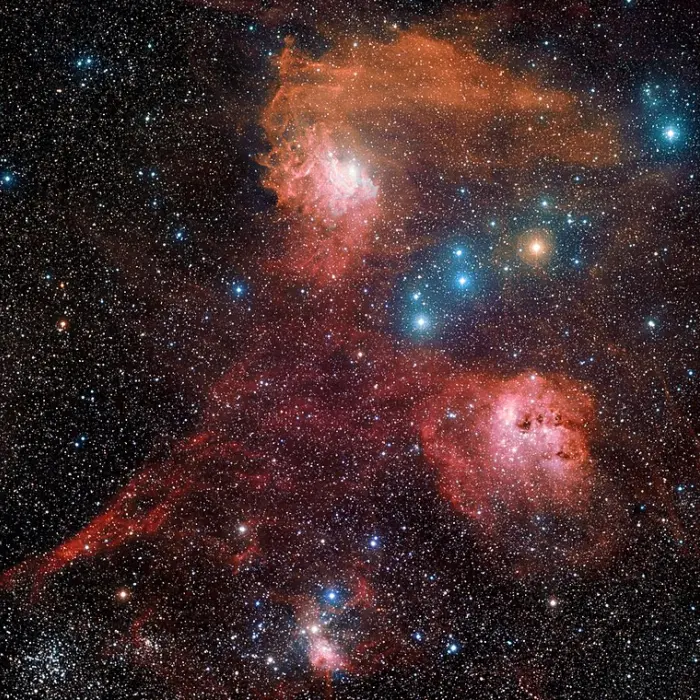
Nebulae IC 405, IC 410, and IC 417 in the constellation Auriga. Near the lower left corner, open clusters Messier 38 and NGC 1907 are easily identifiable. Image credit: Giuseppe Donatiello (CC0 1.0)
The Tadpole Nebula lies only about a degree and a half east of the Flaming Star Nebula. It contains the open cluster NGC 1893.
A telescopic asterism popularly known as the Cheshire Cat or Smiley Face appears between Messier 38 and the Spider Nebula. A smaller open cluster, NGC 1907, appears on the Cheshire Cat’s cheek.
The open star clusters Messier 36 and Messier 37 appear on either side of the imaginary line connecting Mahasim (Theta Aurigae) and Elnath (Beta Tauri).
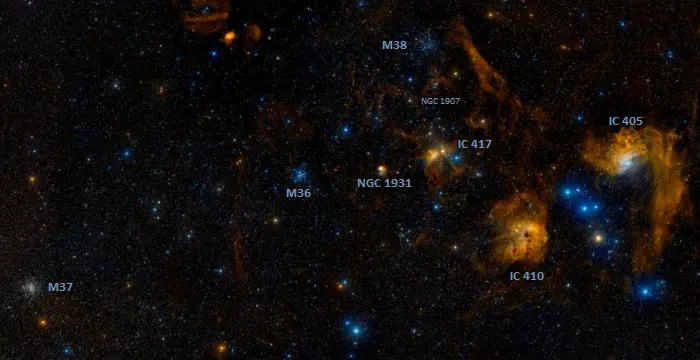
Deep sky objects in Auriga, image: Wikisky
The best time of the year to observe the Flaming Star Nebula and other deep sky objects in Auriga is in late February and early March. The constellation appears high above the horizon in the evening from late October and early November to March.
The Flaming Star Nebula is visible from locations north of the latitude 55° S but it may not rise very high above the horizon for observers in the southern hemisphere.
Flaming Star Nebula – IC 405
| Constellation | Auriga |
| Right ascension | 05h 16m 05s |
| Declination | +34° 27′ 49″ |
| Apparent magnitude | 6.0 |
| Apparent size | 37′ × 10′ |
| Distance | 1,500 light-years (460 parsecs) |
| Radius | 2.5 light-years |
| Names and designations | Flaming Star Nebula, IC 405, Caldwell 31, C31, Sharpless 229, CTB 16, LBN 795 |